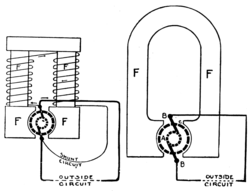Excitation (magnetic)

An electric generator or electric motor consists of a rotor spinning in a magnetic field. The magnetic field may be produced by permanent magnets or by field coils. In the case of a machine with field coils, a current must flow in the coils to generate the field, otherwise no power is transferred to or from the rotor. The process of generating a magnetic field by means of an electric current is called excitation.
Excitation in generators



For a machine using field coils, which is most large generators, the field current must be supplied, otherwise the generator will be useless. Thus it is important to have a reliable supply. Although the output of a generator can be used once it starts up, it is also critical to be able to start the generators reliably. In any case, it is important to be able to control the field since this will maintain the system voltage.
Amplifier principle
Except for permanent magnet generators, a generator produces output voltage proportional to the magnetic field, which is proportional to the excitation current; if there is no excitation current there is zero voltage. A small amount of (electric) power may control a large amount of power. This principle is very useful for voltage control: if the system voltage is low, excitation can be increased; if the system voltage is high, excitation can be decreased. A synchronous condenser operates on the same principle, but there is no "prime mover" power input; however, the "flywheel effect" means that it can send or receive power over short periods of time. To avoid damage to the machine through erratic current changes, a ramp generator is often used.A generator can thus be considered as an amplifier:
Separate excitation

For large, or older, generators, it is usual for a separate exciter dynamo to be operated in conjunction with the main power generator. This is a small permanent-magnet or battery-excited dynamo that produces the field current for the larger generator.
Self excitation
Modern generators with field coils are self-excited, where some of the power output from the rotor is used to power the field coils. The rotor iron retains a magnetism when the generator is turned off. The generator is started with no load connected; the initial weak field creates a weak voltage in the stator coils, which in turn increases the field current, until the machine "builds up" to full voltage.
- Starting
Self-excited generators must be started without any external load attached. An external load will continuously drain off the buildup voltage and prevent the generator from reaching its proper operating voltage.
- Field flashing
If the machine does not have enough residual magnetism to build up to full voltage, usually a provision is made to inject current into the rotor from another source. This may be a battery, a house unit providing direct current, or rectified current from a source of alternating current power. Since this initial current is required for a very short time, it is called "field flashing". Even small portable generator sets may occasionally need field flashing to restart.
The critical field resistance is the maximum field circuit resistance for a given speed with which the shunt generator would excite. The shunt generator will build up voltage only if field circuit resistance is less than critical field resistance. It is a tangent to the open circuit characteristics of the generator at a given speed.